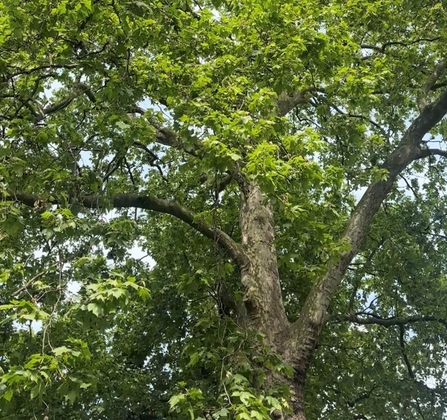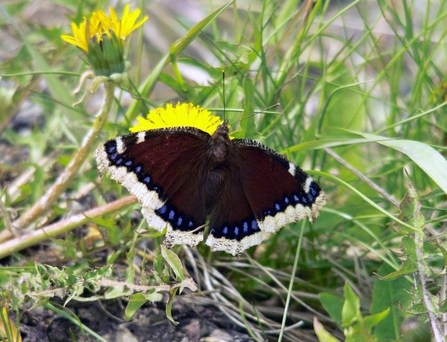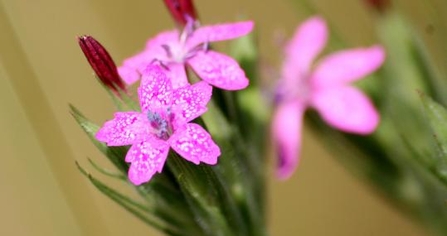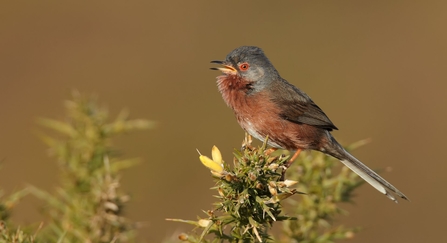
Grey heron with BT Tower credit Terry Whittaker/2020VISION
What's in a name? How some species gained a London epithet
Pinks in Deptford and beauties in Camberwell? Discover London’s denominative flora and fauna...
The massive conurbation that London is today often belies the rural nature of her not-too distant past.
Many of place names throughout the metropolis illustrate this well - such as Acton (farm by an oak tree), Bromley (fields where the broom grows), Forest Hill, and Newham (the new low-lying pastures).
But London has repaid the compliment to some flora and fauna too. Some of these have resulted from the human desire to interfere and experiment with nature, others happened to be in the right place at the right time.
Perhaps ironically, some of these Londonian species are now rarities across the city.
London Plane

Thousands of London plane (Platanus X hispanica) are found in London's streets and parks, making it one of the city's most characteristic trees - the capital is rightly known for them.
Despite its abundance, however, its origins are shrouded in mystery. It probably arose in Spain in the 17th century, either as a hybrid between the oriental plane (P. orientalis) and the occidental (or western) plane (P. occidentalis) from eastern North America, or as a variety of the former.
First planted in England at Ely, Cambridgeshire, and Barnes (then Surrey) in 1680 - both of these trees are still healthy - London planes were eventually widely planted throughout London for their ornamental purposes and ability to tolerate dry and smoky atmospheres.
The oldest London planes include some at Kew Gardens, which are dated to the 1770s, and those at Barn Elms Recreation Grounds and by the Sutton Ecology Centre in Carshalton (claimed to be the largest tree in London), both probably also from the late 18th century.
The trees are now a renowned characteristic of central London's parks and thoroughfares; some authorities suggest it forms almost 50% of all the city's planted trees.
Fulham oak
The Fulham oak (Quercus x hispanica 'Fulhamensis') is a hybrid between the Turkey oak (Q. cerris) and and cork oak from southern Europe (Q. suber), that arose from graftings of an early hybrid in c.1770 at Osborne's Nursery in Fulham.
With dark green leaves and a deeply fissured bark, it is rarely found, being present in a few formal collections.
Camberwell beauty

© Derek Moore
The Camberwell beauty (Nymphalis antiopa) is a large strikingly-coloured butterfly that was first described in this country from a pair found in "August 1748, in Cool Arbour Lane, near Camberwell", as and another "in St. George’s Field, near Newington Butts."
The beauty is, however, a rare immigrant species from Scandinavia and central Europe that has never successfully sustained a population in Britain.
Unmistakeable, with deep chocolate-purple upper wings, fringed with violet specks and cream borders, it became one of the most prized trophies of collectors.
In certain years there are occasional fluxes of Camberwell beauties, such as 1846, 1947, 1976, 1995 and 2006, where individuals have been reported throughout Britain.
At least 57 were reported in London during the long hot summer of 1976, and subsequently others were recorded at south Croydon, Kew, Epping, Loughton, Isle of Dogs, and the Euston Road in the early 1980s.
However, individuals can also be brought in through timber imports from Scandinavia - indeed the Coldharbour Lane sighting might have arrived via such shipments.
Images of the butterfly can be found around Camberwell, for example the shopping centre, and the old baths on Wells Way in Burgess Park.
Moses Harris in his Aurelian (1766) also calls the butterfly 'The Grand Surprize' (a pub in Shirley is called this, with the butterfly as its sign).
It goes by different names in Europe and the USA - mourning cloak, and white petticoat.
London rocket
London rocket (Sysimbrium irio) is a yellow-flowered member of the cabbage family from the Mediterranean.
There it naturally grows like a weed over rocky and disturbed areas, including, for example, the slopes of the volcanic Mount Etna. Its seed production is greatly enhanced by long hot summers.
It arose in great profusion among the ruins of the Great Fire of London in 1666. In the Catalogus Angliae of 1670, the rocket is described as being found on various mounds of earth between the City and Kensington; after the Great Fire it came up in "the greatest plenty in 1667 and 1668 within the walls on the rubbish heaps around St Paul's Cathedral."
However, London rocket's place in 20th century London has partly been taken over by rosebay willowherb, also known as fireweed.
A site near Bloomsbury between 1901 and 1912 revealed a few specimens, which appeared to be the last records of it in London. No London rocket was found in a survey of the blitzed ruins of 1940, but it was 'rediscovered' in 1945 in and around the Tower of London.
It can still be found on the remains of the London Wall by Tower Gateway station, as well as near London Zoo, flowering in late June.
Deptford pink

© Janet Powell
Deptford pink (Dianthus armeria) is a deep-pink coloured member of the campion family, and probably a classic case of mis-identity.
It was depicted by John Gerard in his Of the Historie of Plants (1597), described as being found abundantly "in our pastures neare about London, especially in the great field next to Detford by the path side as you go from Redriffe [Rotherhithe] to Greenwich."
However, when Thomas Johnson revised Gerard's herbal in 1633, the illustrations of two pinks were transposed.
The pinks described by Gerard as "a wide creeping pinke...which hath many small tender leaves, shorter than any of the other wilde pinkes... The roote is small, tough and long lasting" were certainly the species now known as the maiden pink (D. deltoides).
As the first name given to a plant is generally the one botanists stick to, Deptford is famous for a plant that has possibly never grown there.
In the 17th century it was noted that Deptford pinks were "among the thicke grass towards Totnam Court, near London", and "in a little wood cut down … a little beyond the bottom of the hill beyond Highgate."
A species of open grassland benefiting from occasional disturbance, the loss of grazing has contributed to the pink's decline, which has been obvious but gradual, being recorded at Croham Hurst until 1924, Parliament Hill until 1948, and Richmond Park until 1952.
Since 1965, Deptford pink has only been recorded from one site in London, on the rural fringes at Skeet Hill, east of Orpington.
It is now confined to less than 40 sites in Britain, mostly in the south east, and not now found in Greater London at all.
The maiden pink is long gone from Deptford, and probably also extinct in London too.
London pride
London pride (Saxifraga spathularis x umbrosa) is a garden escape, and a sterile hybrid of St. Patrick's cabbage - a saxifrage - that has been known since the 17th century.
Tradition holds that London pride rapidly colonised bomb sites of the Blitz of the early 1940s, and therefore symbolic of the resilience of Londoners, and of the futility of bombing them into submission.
Noel Coward's song London Pride of 1941 celebrates the flower and the city, and achieved great popularity during the war years:
"There's a little city flower every spring unfailing, Growing in the crevices by some London railing, Though it has a Latin name, in town and country-side, We in England call it, London Pride."
In the language of flowers, London pride is held to stand for frivolity, and its day is 27th July.
Dartford warbler

© Richard Steel/2020VISION
The Dartford warbler (Sylvia undata), who's namesake lies just outside London, was nevertheless first recorded as a British breeding bird at Bexley Heath in 1773.
It was found in comparatively common numbers at Hampstead, Highgate and Finchley in the 1860s, and was actually shot at Wormwood Scrubs and Old Oak Common.
However, the vulnerability of this bird to human activities meant that it couldn't survive for many years as London grew rapidly from the 1840s.
In the 1930s it was sighted at Wimbledon Common, Richmond Park and some of the heathy fringes of the south-west London borders.
Building development, egg collecting, fires and military manœuvres on the remaining London heaths contributed to its local extinction, although the coup de grace was undoubtedly administered by the severe winters of 1938-9, 1941-2 and 1947.
The Dartford warbler - the only resident warbler in Britain - is now a rarity in the country, confined to the heaths of southern England, especially around Purbeck.
However, since its near extinction in the 1960s has recovered to over 3,000 pairs.
Even more remarkable is the sub-species of mosquito adapted to life below ground.
London Underground mosquito
The London Underground mosquito (Culex pipiens molestus) appears to have adapted to life in the tube following the use of stations during the Blitz.
Although first discovered in the London Underground system, this mosquito has been found in similar systems around the world, and it may have adapted to human-made underground tunnels since the last century from local, above-ground species.
More recent evidence suggests that it is a southern mosquito variety related to C. pipiens that has adapted to the warm underground spaces of northern cities.
These appear to be the only wildlife blessed - or cursed - with a London name today. There were other plants and animals which bore local names that have since disappeared as other names took hold.
For instance, the wall butterfly (Lasiommata megera) was described as the London eye in 1717. The speckled wood (Pararge aegeria) - London's commonest woodland butterfly - was once known as the Enfield eye.
And another butterfly, the Glanville fritillary (Melitaea cinxia) was listed in the 18th century as the Dullidge fritillary [Dulwich].
The blotched emerald (Comibaena bajularia) is a green geometrid moth once called the Maid of Honour, after Honor Oak where it was first discovered.
Brent geese (Brantia bernicla), however, have no connection with Neasden or Willesden, and poplar trees (Populus sp.) may have lent their name to the neighbourhood of Poplar, but not the other way round.
That said, there still may be countless numbers of microscopic invertebrates in London's woods and wastelands, rooting away awaiting to be discovered and named.
Who knows - may we still yet see a Barking 'biter', and Hornsey hornet, or a Stepney staphylinid in the taxonomies of the future?
